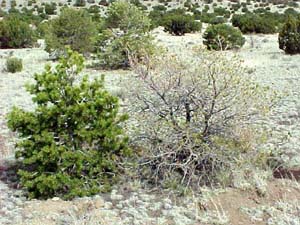
Introduction to our Study System |
||
|
||
Effects of Recent Environmental Change on the Pinyon - Herbivore - Mycorrhizal Community of Sunset Crater: The past 25 years of studying how environmental stress affects plant- herbivore- mycorrhiza- vertebrate interactions at Sunset Crater have revealed a dynamic system that has affected the ecology and perhaps the evolution of a major community type in the Southwest. After the 200 year eruption of Sunset Crater that ended in about 1300AD, the plants and animals that recolonized the 2,000 km2 of ash, cinder and lava fields encountered a hotter, dryer, and nutrient poor environment for which they are marginally adapted.In this stressful environment, the dominant trees, pinyon pine, one-seed juniper and ponderosa pine (listed in order of abundance) suffer chronic attack from one or more diverse pests (seed parasites, stem borers, scale insects, sawflies, and mistletoe) that negatively affect their growth and reproduction (Whitham and Mopper 1985, Mopper et al. 1991, Gehring and Whitham 1992, DelVecchio et al. 1993, Cobb et al. 1996). For example, pinyons are sequentially attacked by two major herbivores as pinyons shift from juvenile to mature growth. From the seedling stage to the beginning of reproduction, 90% of the trees are infested by the pinyon needle scale, Matsucoccus acalyptus, which reduces biomass 4-fold. When pinyons mature, they become susceptible to the stem-boring moth, Dioryctria albovittella, which causes a 50% decline in biomass, a switch in architecture from tree-like growth to shrub-like growth, and causes an associated sex change whereby susceptible trees loose their female function to become male-only plants. Recent studies (Koch et al. unpub. data) show major differences in the nitrogen content of needle litter under resistant and susceptible trees suggesting that insect herbivores can dramatically alter the nitrogen cycle. Because pinyons dominate a habitat type that covers 20 million hectares, the interaction of environmental stress and herbivory on pinyon performance will impact the rest of the community. Three major groups of organisms (about 1000 species) are affected. First, our long-term studies of individual trees and sites shows that insect susceptible pinyons at Sunset Crater also suffer a 30% loss of their mycorrhizal mutualists (Gehring and Whitham 1991, 1994a, 1995a). Recent findings show that the composition of 50 mycorrhizal mutualists of pinyons and several hundred microbial species shift dramatically in this new environment (Gehring et al. unpub. data; Kuske et al. unpub. data). Second, the negative impacts of moths and scales on susceptible pinyons affect other arthropods such as sawflies (Mopper et al. 1990; Mopper and Whitham 1992). Recent studies of the 300 arthropods associated with pinyons show that species richness declined by 50% and abundance declined to 1/12th the normal level at Sunset Crater relative to nearby sandy-loam sites (Cobb et al. unpub. data). Third, even vertebrates are affected. Major seed dispersing mutualists such as Pinyon Jays, Scrub Jays, and Clark’s Nutcrackers abandon moth susceptible trees at Sunset Crater because with low cone crops foraging is unprofitable (Christensen and Whitham 1991, 1993). Pinyon seed predators, such as the pinyon mouse have also altered their foraging behavior to better discriminate among more variable resources (Wade et al. 1996). |
||
